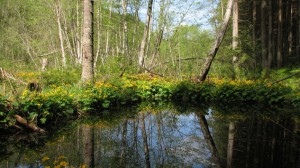
Forests can retain excess rainwater, prevent runoff, and reduce flood damage. Image by Annemarie Bastrup-Birk
Forests cover one third of European territory, and approximately 296 million Europeans live in or close to forests. On Sept. 24, the European Environment Agency (EEA) published a new report that provides an overview of the water-retention potential of European forests. Water retention by forests affects the amount and timing of the water delivered to streams and groundwater by increasing and maintaining soils’ infiltration and storage capacity. These forests retain excess rainwater, prevent runoff, and reduce flood damage. By releasing water in the dry season, forests can also help provide clean water and mitigate the effects of droughts.
The EEA report Water-retention potential of Europe’s forests is intended to inform measures to tackle the effects of climate change and extreme weather events.
The volume of water retained by forests can depend on characteristics such as forest cover area; growing season length; tree composition, density, and age; as well as the number of layers of vegetative cover. The report shows that water retention potential tends to increase along with the extent of forest cover in a water basin. Compared to basins with a forest cover of only 10%, total water retention is 25% higher in water basins where the forest cover is more than 30%, and in basins with 70% forest cover, retention is 50% higher.
Irrespective of the extent of the basin’s forest cover, water retention is typically about 25% greater in summer than in winter, and coniferous forests in general retain 10% more water than broadleaved forests or mixed forests. In general, forests in Alpine and Continental regions have the highest water-retention potentials, while Atlantic and Mediterranean regions register lower water-retention potentials.
Despite the powerful capability of forests to retain water, reforestation and preservation are not a one-size-fits-all stormwater solution. According to the EEA, these solutions should be considered alongside other options with regard for local and regional ecological and hydrological conditions as proposed in the European Commission’s natural water-retention measures catalog.



